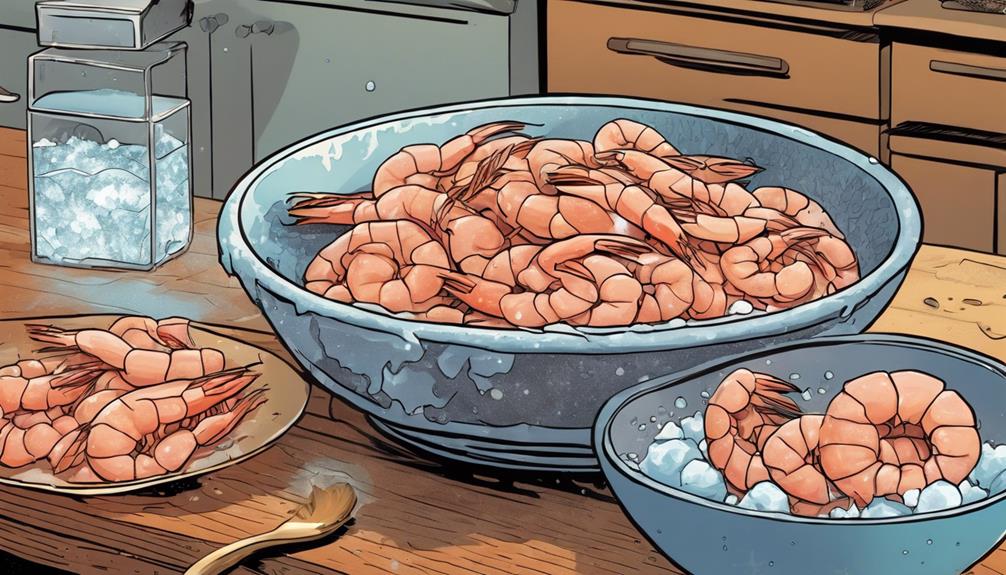When cooking frozen shrimp, you should thaw it before cooking to guarantee even texture, juiciness, and proper cooking. Thawing allows for better flavor absorption and prevents uneven cooking. There are quick thawing methods like submerging in cold water or using a microwave, while slow thawing in the refrigerator enhances texture and flavor. By prioritizing proper handling and following food safety guidelines when cooking frozen shrimp, you can create a delicious dish. Remember to season your shrimp before cooking and avoid overcrowding the pan for the best results. If you're looking to enhance your frozen shrimp cooking skills, make sure to follow these tips for a tasty outcome.
Main Points
- Thawing ensures even cooking and better texture.
- Quick thawing methods expedite the cooking process.
- Slow thawing in the refrigerator preserves juiciness and flavor.
- Thawed shrimp should be used within 1-2 days for optimal quality.
- Cooking frozen shrimp without thawing is safe and practical.
Benefits of Cooking Frozen Shrimp
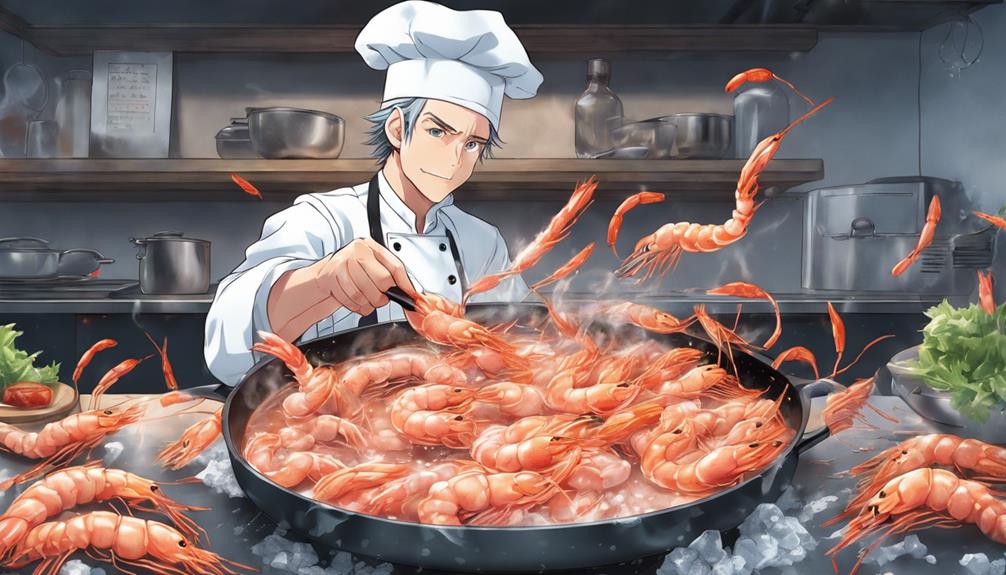
When cooking frozen shrimp, you can guarantee their freshness and natural flavors by following proper thawing techniques. Thawing the shrimp before cooking allows for even cooking and better texture. By giving the shrimp time to thaw slowly in the refrigerator, you prevent the risk of uneven cooking where the outside is overdone while the inside remains frozen. This method also helps the shrimp retain its moisture, resulting in a juicier and more flavorful final dish.
Thawing frozen shrimp before cooking also secures food safety. Allowing the shrimp to thaw in the refrigerator reduces the chances of bacterial growth that can occur when thawing at room temperature. Properly thawed shrimp decreases the risk of foodborne illnesses, making it a safer option for consumption.
Moreover, thawing frozen shrimp before cooking gives you more control over the seasoning and marinades. When the shrimp is fully thawed, it can absorb flavors more effectively, enhancing the overall taste of your dish. Additionally, thawed shrimp cooks more evenly, allowing your seasonings to distribute consistently throughout the shrimp, resulting in a more delicious meal.
Downsides of Cooking Frozen Shrimp
Thawing frozen shrimp before cooking can have its downsides, particularly when it comes to time efficiency and convenience. Here are some of the drawbacks you might encounter:
- Time-consuming process: Thawing shrimp can take up valuable time, especially if you're in a rush to prepare a meal.
- Loss of juiciness: Frozen shrimp tends to release more moisture as it thaws, potentially leading to a less juicy final dish.
- Risk of bacterial growth: The longer shrimp sits at room temperature during thawing, the higher the risk of bacterial growth, which can affect food safety.
- Texture changes: Thawing shrimp before cooking can sometimes result in a slightly different texture compared to cooking it from frozen.
- Flavor loss: There's a possibility that some of the natural flavors of the shrimp may be lost during the thawing process, impacting the overall taste of the dish.
Considering these downsides, you may want to explore alternative cooking methods for frozen shrimp that save time and preserve the quality of the final dish.
Quick Thawing Methods
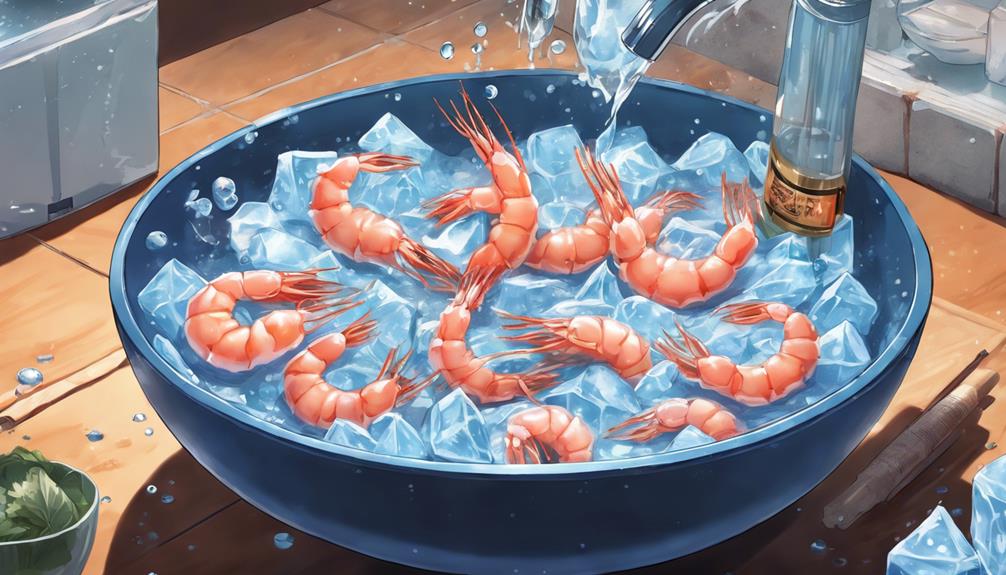
To expedite the thawing process for frozen shrimp, efficient methods that minimize time and maintain quality can be employed.
One quick method is to place the frozen shrimp in a sealed plastic bag and submerge it in a bowl of cold water. Change the water every 30 minutes to guarantee a consistent thaw. This technique can take about 1-2 hours depending on the amount of shrimp.
Another option is to use the defrost setting on the microwave. Place the shrimp in a microwave-safe dish, and select the defrost setting based on the shrimp's weight. Be cautious not to cook the shrimp during this process. Microwave thawing typically takes around 5-7 minutes per pound.
Additionally, you can run cold water over the shrimp in a colander, making sure the water drains away from the shrimp to speed up the thawing process. These quick thawing methods are practical solutions when you need to cook frozen shrimp promptly.
Slow Thawing Methods
For a more gradual thawing process that enhances the texture and flavor of your frozen shrimp, consider utilizing the refrigerator method. This method allows the shrimp to thaw slowly and safely, preserving its quality.
Here are some steps to follow for successful slow thawing:
- Place the frozen shrimp in a leak-proof plastic bag to prevent any potential leakage.
- Place the sealed bag on a plate to catch any liquid that may drip during thawing.
- Place the plate with the shrimp in the refrigerator.
- Allow the shrimp to thaw in the refrigerator for approximately 8-12 hours, depending on the quantity and size of the shrimp.
- Once defrosted, make sure the shrimp is used within 1-2 days for the best quality and taste.
Cooking Frozen Shrimp Safely
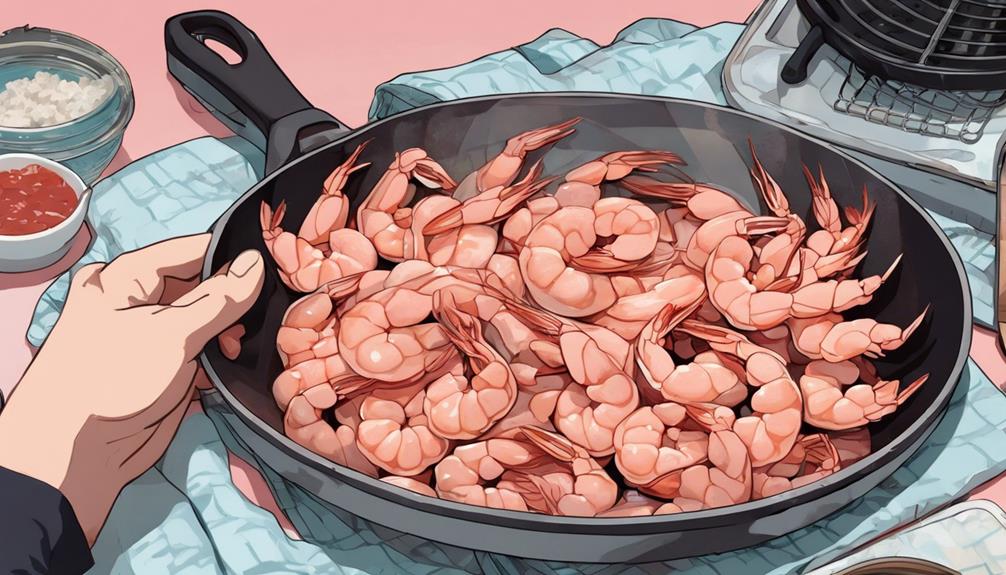
To guarantee proper handling and minimize the risk of contamination, always prioritize cooking frozen shrimp safely following recommended food safety guidelines. Begin by preheating a skillet or pan over medium heat and adding a small amount of oil or butter. Once the pan is hot, carefully add the frozen shrimp. Cook the shrimp for about 2-3 minutes on each side until they turn pink and opaque. To make certain thorough cooking, use a food thermometer to check that the internal temperature of the shrimp reaches at least 145°F (63°C).
Avoid overcrowding the pan to allow the shrimp to cook evenly. If you prefer a different cooking method, you can also bake frozen shrimp in the oven. Preheat the oven to 375°F (190°C) and place the frozen shrimp on a baking sheet. Bake for approximately 10-12 minutes until the shrimp are fully cooked.
Remember to always wash your hands, utensils, and surfaces after handling raw shrimp to prevent cross-contamination. By following these steps, you can safely cook delicious frozen shrimp for a tasty meal.
Seasoning Frozen Shrimp
When seasoning frozen shrimp, make sure to enhance their flavor without overpowering their natural taste by using a balanced combination of herbs and spices. Here are some tips to season frozen shrimp effectively:
- Garlic and Lemon: A classic combination that adds an invigorating zest to the shrimp.
- Paprika and Cumin: These spices add a smoky and earthy flavor to the shrimp.
- Herbs like Parsley and Dill: Fresh herbs can brighten up the dish and complement the natural sweetness of the shrimp.
- Cayenne Pepper or Chili Flakes: For those who enjoy a bit of heat, these spices can add a nice kick to the shrimp.
- Salt and Pepper: Always remember the basics – a good sprinkle of salt and pepper can enhance the overall taste of the shrimp without being too overwhelming.
Tips for Cooking Frozen Shrimp
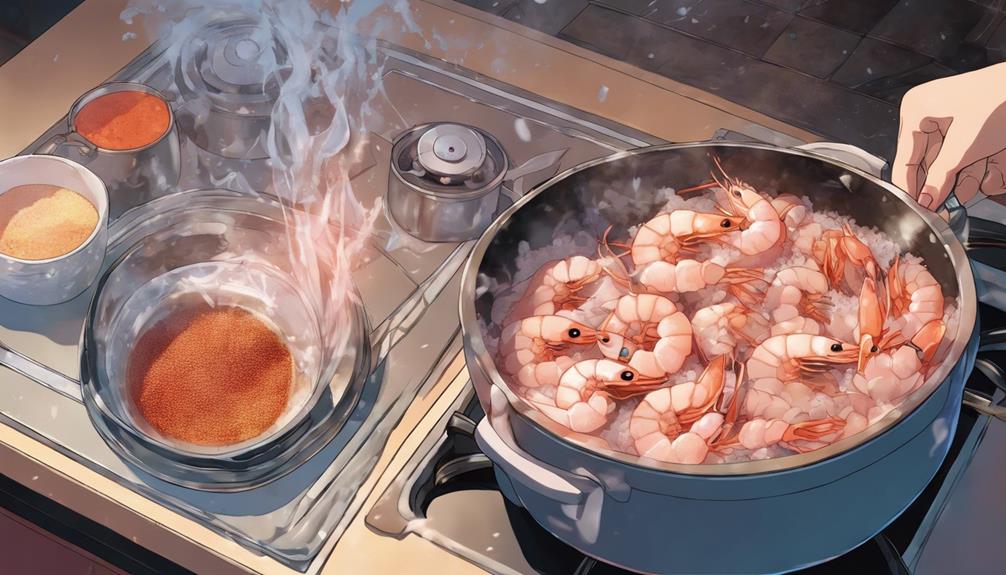
Consider thawing frozen shrimp in the refrigerator overnight or under cold running water for quicker preparation before cooking to guarantee they cook evenly and retain their natural moisture. When cooking frozen shrimp, there are a few key tips to keep in mind for the best results.
Initially, make sure your pan or skillet is preheated before adding the shrimp. This helps in achieving a nice sear and prevents the shrimp from sticking. Additionally, avoid overcrowding the pan. Cooking the shrimp in batches allows for proper cooking without steaming.
Season the shrimp with your preferred spices or marinade before cooking to enhance the flavor. Cook the shrimp for 1-2 minutes per side until they turn pink and opaque. Overcooking can result in rubbery shrimp, so keep a close eye on them. Remove the shrimp from the heat as soon as they are cooked through to prevent them from becoming tough. The best way to not overcook shrimp is to monitor them closely and cook them just until they lose their translucent appearance. Serve immediately for the freshest taste and pair with your favorite sides or sauces.
Once cooked, remove the shrimp from the heat promptly to prevent them from continuing to cook in the residual heat. By following these tips, you can enjoy perfectly cooked frozen shrimp every time.
Conclusion
To sum up, cooking frozen shrimp without thawing can be a convenient and time-saving option.
While there are some downsides to this method, such as potential uneven cooking, there are also benefits like preserving the shrimp's freshness and flavor.
Remember to follow safe cooking practices and consider different seasoning options to enhance the taste of your dish.
Just like a skilled chef, you can master the art of cooking frozen shrimp with ease and creativity.
